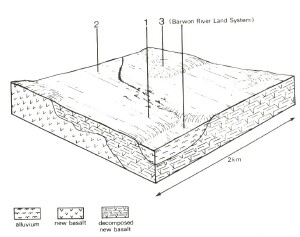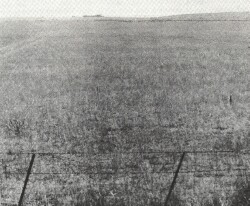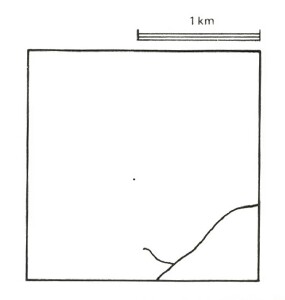Winchelsea Land System
Download the pdf version of this document: Winchelsea Land System (PDF - 220 KB)
To view the information, PDF requires the use of a PDF reader. This can be installed for free from the Adobe website (external link).
| Basaltic plains north of the Barwon River are typical of those found in much of western Victoria. These plains are relatively featureless, although there are occasional outcrops of basalt in the form of stony rises or scarps. The soils are duplex with heavy clay subsoils. Permeability is very low and waterlogging occurs during the wetter months. Gilgais are a feature of the landscape. Grazing of sheet and beef cattle is the main land use, and there is some cereal and oilseed cropping. The climate is relatively dry, but suitable for agriculture, and improved pastures have normally been established. Soil salting occurs in many parts of the landscape, particularly close to the Barwon River. |  |
 These flat basalt plains contain very few remnants of the organic native vegetation. |  |
Area: 80 km2 | Component and its proportion of land system | ||
1 15% | 2 75% | 3 10% | |
| CLIMATE Rainfall, mm | Annual: 550 – 600, lowest January (25), highest August (60) | ||
| Temperature, 0oC | Annual: 13, lowest July (8), highest February (19) | ||
Temperature: less than 10oC (av.) June – August | |||
Precipitation: less than potential evapotranspiration late September – April | |||
| GEOLOGY Age, lithology | Pleistocene basalt | ||
| TOPOGRAPHY Landscape | Flat to gently undulating plain abutting the north side of the Barwon River | ||
| Elevation, m | 110 – 150 | ||
| Local relief, m | 15 | ||
| Drainage pattern | Dendritic | ||
| Drainage density, km/km2 | 0.2 | ||
| Land form | Plain | ||
| Land form element | Flat southern lower areas | Most flat or undulating slope | Rise |
Slope (and range), % | 0 (0-1) | 1 (0-3) | 2 (0-4) |
Slope shape | Linear | Linear | Convex |
| NATIVE VEGETATION Structure | Open woodland | Possibly open woodland | Possibly open woodland |
| Dominant species | E. camaldulensis | E. camaldulensis | E. camaldulensis |
| SOIL Parent material | In-situ deeply weathered basalt; some alluvium | In-site deeply weathered basalt | Basalt |
| Description | Grey calcareous sodic duplex soils, coarse structure | Grey calcareous sodic duplex soils, coarse structure | Black calcareous clay soils, uniform texture |
| Surface texture | Sandy loam | Clay loam | Clay |
| Permeability | Very low | Very low | Very low |
| Depth, m | 1.8 | 1.2 | 0.7 |
| LAND USE | Cleared areas: Sheep and beef cattle grazing; cropping | ||
| SOIL DETERIORATION HAZARD Critical land features, processes, forms | Soils of low permeability are prone to waterlogging and to salting where high water tables occur. | Soils of low permeability are prone to waterlogging and to salting where high water tables occur. | Minor hazards |


